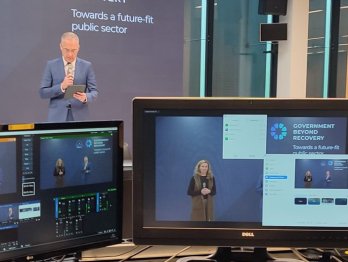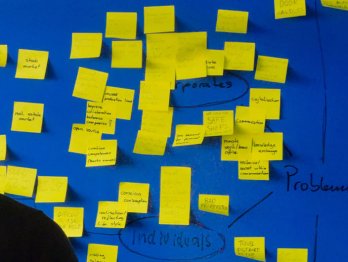COVID-19: Innovative responses update #8

This is our eighth update about innovative responses (including public sector innovation, digital government or open government) being undertaken around the world. Thank you again to all who have contributed in answer to our call and to our partners (including the Centre for Public Impact and GovInsider) for helping us to collect innovative practices. We hope that teams around the world can learn from each other and take inspiration from the information collected. There are now nearly 400 examples and initiatives in the collection, helping deepen our knowledge and understanding of how the public sector and its partners are responding to one of the most significant crises of recent times.
What can we observe from the additions made since our last update?
- Infection control or tracking measures: The Spanish Government had the armed forces cooperate with the national health authorities in setting up 16 field hospitals. Serbia introduced a number of novel technologies for infection control as a result of its innovation fund, including Aditus gate, a decontamination cabin to aid in hospitals; an innovative disinfection tunnel; SURFIX, a new disinfectant with antiviral action; Ozon-Care, portable ozonizers for fast and safe disinfection of facilities; Life Masks, reusable protective masks; a Serbian ventilator; and HERMES-COVID, a messaging platform allowing doctors and nurses to receive messages and instructions in real-time from the crisis management team. Austria created a dashboard for data about the pandemic including the number of tests undertaken, infections, numbers in intensive care units and deaths, and made available all relevant statistical data about the spread of the virus. Colombia likewise provided open data about the pandemic, as did Italy, Japan, Lithuania, Israel and the Danish Government published data and statistics on a daily basis. A number of countries have developed contract tracing apps, including Iceland, Norway, and Cyprus. In Italy, there was a tracking app “Digital Arianna”, diAry, a web-app that also provides vouchers for users, which merchants and suppliers of services can attribute a value to and grant discounts and concessions.
- Improving communications/providing targeted information: During the crisis, the New Zealand Police used humorous and citizen-submitted videos for their crisis communications efforts. In the Czech Republic, a private sector provider developed FreMEn Adviser, an app that will advise users when to visit public places to avoid, for example, regularly crowded shops, parks and playgrounds. A similar app was developed in Israel, Crowdless, to help people make informed decisions and navigate more safely as they carry out their essential tasks, providing real-time live data on the busyness of essential places that people need to visit, such as supermarkets and pharmacies.
- Service delivery in a crisis/adjusting to context: the Ministry of Agriculture in Serbia initiated the first e-greenmarket to aid smaller producers to be able to sell their produce while the physical markets were shut, and this has continued to be used by retail chains even after the end of the state of emergency.
- Leveraging and redeploying existing resources and solutions: The Indian Department of Science and Technology set up a COVID 19 Task Force for mapping of technologies from R&D labs, academic institutions, startups, and MSMEs to fund nearly market-ready solutions in the area of diagnostics, testing, health care delivery solutions, and equipment supplies.
- Open calls, hackathons and other challenge-mechanisms: Serbia issued a public call for scientific and research projects within the Special Research Program on COVID-19, and there was a crowd-sourced ‘Solution Challenge’ in India for citizens to submit their solutions for potential scaling up by the government. India also ran a ‘Hack a Cause’ online hackathon in connection with the global hackathon that was run. At the local government level in India, ‘Breath of Hope‘ was established, a team of multidisciplinary volunteers, including IT professionals, biomedical engineers and doctors, to generate potentially innovative medical tech solutions that would otherwise have not been possible such as different types of masks.
- Structural responses and possible longer-term shifts: Transport Canada has announced its intention to shift to a default ‘work from home’ policy.
Reflections and new thinking
While collecting innovative responses, we are simultaneously keeping an eye on the long term.
There is a growing consensus that this is an opportunity to re-examine, rethink, and rebuild. The question is how to make sense of the many ideas suddenly gaining attention, the competing narratives, and even mental models for how to think of this period in time and how we will shift into a post-Covid world. Is this a war? A crisis? An opportunity? A portal into new possibilities? In fact, a community is collecting the metaphors used to describe Covid-19 because of how it can shape our perceptions.
The Danish Design Centre’s Christian Bason says that “our societies will likely be more value-oriented, local and green” and calls for more “empathy for the future.” Long entrenched in environmental economics literature as the “precautionary principle,” Bason argues that the Covid-19 proves that we cannot be so confident in how the future will flow gently from the present that we shouldn’t empathize more with future generations in plausible future scenarios. In Canada, opposing op-eds are debating, for and against, the idea of a “green recovery.”
The World Bank raises the alarm that financing approaches will need to adjust to maintain food security as Covid-19 impacts the otherwise robust food system via sanitary measures, labor shortages, and logistics flows, while the UNDP-funded Youth Co-Lab lays out a series of actions to support those who might otherwise fall through the cracks of hastily constructed, best-guess policy.
A new European Commission Expert Group focused on the Economic and Social Impact of Research and Innovation looks at the meta level of these issues, calling for systematically increased capacity for understanding and navigating horizontal, complex, and unknowable futures through 15 innovation-focused recommendations.
The OPSI team will be continuing to collect, curate, and foster community sensemaking of these narratives up to and through Government After Shock.
Caveat
The innovative initiatives here are represented as best as we can, given the information available. Additionally, these examples are included as observations, with no judgement made about their merits. Innovative responses are, by definition, new, and it takes time to know whether new things work, and if they work, whether they are appropriate or wanted.
If you know of other examples, we want to hear from you
We need your help in continuing to add innovative initiatives to the coronavirus crisis to our tracker and in disseminating the call. This not only helps us to gather data to inform our research and support of governments, but it helps others to share ideas and replicable solutions with others around the world. All our work on this topic will feed into the broader work of the OECD in compiling data, information, analysis and recommendations regarding the health, economic, financial and societal challenges posed by the impact of Coronavirus (COVID-19). Please visit the dedicated page for a full suite of coronavirus-related information.









